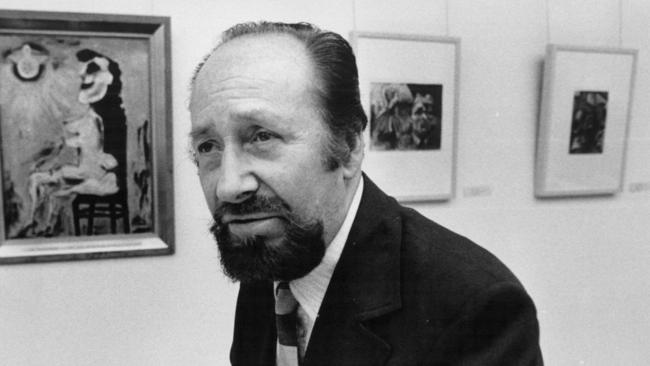Art as a tool to protest evil
Born 100 years ago today, Australian artist Albert Tucker was shaped by his sensitive nature, the poverty of his Depression-era childhood and the suffering of wounded soldiers

Today in History
Don't miss out on the headlines from Today in History. Followed categories will be added to My News.
Born 100 years ago today, Australian artist Albert Tucker was shaped by his sensitive nature, his Depression-era childhood and the suffering of wounded soldiers.
Tucker was repelled by wartime immorality and societal degradation. His violently expressive art, described by critic Robert Hughes as “craggy and harsh”, recalled the work of the German expressionists. “There is no doubt Tucker ... went through the same angst in the face of a corrupt environment as Grosz and Kirchner did,” Hughes wrote.
Albert was born in Melbourne, the third and last child of John and Clara Tucker.
Clara’s aspirations to a middle-class suburban life evaporated in the face of her husband’s lack of drive and ambition. John worked as an undergear repairer on the Melbourne railways, clearing a meagre wage that saw the family slide into dire financial difficulties.
They lost their house and were forced to rent, and Albert’s childhood was haunted by a terror of debt collectors. In 1929, aged 14, he left school to help support the family as a housepainter and commercial illustrator.
Tragedy stuck when Albert was 17. His older brother, Jack, died at home of meningitis. Albert felt his brother’s heart stop beating. Tucker’s personal traumas would underpin the emotional intensity of his paintings.
“Grief has to be lived through, I think, and activated from time to time,” Tucker told an interviewer when he was 80 years old.
Albert was a natural draughtsman and in 1933 he started attending a life drawing group at the Victorian Artists’ Society. Apart from that, he was mostly self-taught.
In the 1930s, Tucker was part of what Hughes called “a new tone of discontent” among Melbourne artists. “Their art was a tool of protest against a world which had spun off its axle, and now, like a flywheel gone amok, was smashing all values with its ponderous momentum: the world of the Depression, the Spanish Civil War, and the Second World War,” Hughes wrote.
Joining Tucker as part of the so-called Angry Decade (1937-47) were artists Sidney Nolan, Danila Vassilieff, John Perceval, Arthur Boyd and Yosl Bergner. Tucker began exhibiting his work in 1936 and was drafted into the army in 1940. He was assigned to the Heidelberg Military Hospital in Melbourne to do medical drawings of wounded and mentally afflicted soldiers.
One soldier, whose entire nose had been sliced off, featured in Tucker’s drawing Man At Table. The plastic surgery ward at Heidelberg “gave me images that I have fed on all my life”, Tucker said when he was 80. His disgust with humanity culminated in his 1943-1948 series, Images Of Modern Evil, which Hughes said was “among the most important achievements in the formative years of modern Australian art”.
The series’ paintings were characterised by leering faces and images of soldiers and prostitutes, and they did not go down well with the public. The series was kept by Tucker until the late-1970s when much of it was acquired by the National Gallery of Australia.
Tucker married artist Joy Hester in 1941 and the couple enjoyed the financial stability of their place in the inner circle at Heide, the rural property owned by wealthy art patrons John and Sunday Reed. The Reeds even paid Tucker a stipend. Hester gave birth to a son, Sweeney, in 1945.
Tucker left Australia in 1947, declaring himself to be “a refugee from Australian culture”. He disembarked in Japan where he witnessed the destruction wrought by the atomic bombs dropped on Hiroshima and Nagasaki.
Returning briefly to Australia, Tucker discovered Hester had left him for artist Gray Smith. Leaving two-year-old Sweeney with the Reeds, Tucker again left Australia, this time living in Europe, including five years in Paris. During this period he allowed the Reeds to adopt Sweeney, revealing decades later his belief that the childless Sunday Reed had orchestrated the situation. Sunday Reed was, Tucker said, an “interferer in people’s marriages”. After finishing his overseas travels with two years in New York, Tucker returned to Australia in 1960 where his first solo exhibition heralded a period of great popularity for his work.
That same year Hester died and, in 1964, Tucker began a happy marriage to Barbara Bilcock.
Sadness returned in 1979 when Sweeney committed suicide.
In 1990, more than 90,000 people visited a retrospective exhibition of Tucker’s work, honouring a man who saw “a creative potential in everything that happens to us, good and bad”. He died in 1999, and is survived by his wife.
elizabeth.fortescue@news.com.au
Originally published as Art as a tool to protest evil


